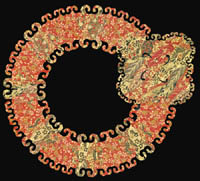
|
Ways to Customize your Jardin Puzzle | ||
|
Of course the first way to personalize your puzzle is to choose a picture, be it a photograph, a print, a map, a card or some thing else that is special to you or the person receiving the puzzle. Next you should decide how difficult the puzzle should be. If a puzzle is too hard, it's not enjoyable. If it's too easy, it's not a challenge. The cutting style and features like irregular edges, color-line-cutting, figurals, and trick pieces all determine the degree of difficulty for a puzzle. Different Cutting StylesChoosing a cutting style is matter of preference, desired degree of difficulty, and asthetics of matching the style to the image. I have customers that always request the same style just because they like it. Other customers want either an easy puzzle or a difficult one and choose accordingly. Sometimes, I just match the style to what looks good with the image. For example, for snowy images I sometimes use the Continuous Knob style (see below) because it looks like round clumps of snowflakes. I've just added a new style I've deemed "Random fun". See why below. Most mass-produced paper puzzles use what is called a "strip cut". The cardboard is die-cut using a two presses with metal cutting stripes, one aligned vertically, the other horizontally. Each interior piece interlocks with its 4 neighbors and has either a knob or a socket on all four sides. This cut is one of the easiest to assemble because of its regularity. The styles we offer make more difficult puzzles and produce puzzle patterns and individual pieces that are beautiful by themselves. Of course, we can do a strip cut as a special request, but the styles below are the main Jardin Puzzle styles. We've added a new one at the end of the list. Random Knob , Random Heart (Earlet), and Random Curl (Scroll) Cut. This cut is not done by strips but has wavy lines between "knobs". Knobs can be round like doorknobs which we call a Random Knob cut. If they are shaped like the upper part of a heart (or an ear on its side), the style is called Random Heart, and if the knob is a curl, we call it Random Curl.
Because of the random connecting lines, each piece has an arbitrary number of adjacent pieces instead of the "four sides" in a strip cut puzzle. Not knowing how many pieces border another and where the borders start and stop makes this type of puzzle more difficult to assemble than the strip cut. Continuous Knob, Heart Cut and Continuous Curl Cut. These cutting styles are made by continually cutting round knobs, hearts or curls with little or no connecting lines. A continuous cut of either knobs, hearts, or curls is the most difficult to assemble because the pattern is repetitive. Unlike the random styles, there are no semi-straight edges on either side of a "knob" to show how it fits together. Instead, the "knobs" interlock and it is not obvious where or how.
These puzzles may be cut piece by piece, or in a maze-like section that is then cut into individual pieces The example below shows a small picture that has been cut into two sections using a continuous curl pattern. In particular, the Continuous Curl style results in beautiful scroll-like pieces.
Curls and Knobs
.
Random Fun .
Other cutting styles . Irregular Edges
Puzzles don't have to be rectangular with straight edges. Some examples of irregular edges include: Dropouts, or Intentional Holes in the PuzzleAs the name implies, dropouts are portions of the interior of the puzzle that are intentionally cut out. Our best example of this technique is in our Iris Hispanica puzzle. Not only does it have a highly irregular edge, it has over 30 dropouts!
Color Line Cutting (CLC)In addition to irregular edges, a puzzle may be cut along the color lines of the print. This makes the assembly more difficult since the usual clues of border pieces have been eliminated. There is a direct trade-off with interlock-ability and CLC. Unless the patterns of the colors are interlocking, cutting along the line of color introduces a semi-straight edge that is not interlocking with the rest of the puzzle. In the puzzle below, you can see the CLC around her hair, face and arms.
Figural or Whimsie piecesFigurals, or as they were called in Britain, whimsies, began to be popular at about the turn of the 20th century. They were special pieces put in at the whim of the cutter. They were one piece or a multiple pieces. Today we design special figural peices to your request. They can either complement the puzzle image, or be a personal touch such a object from a favorite sport or hobby. The Reverie puzzle, pictured in the CLC section above, has single piece figurals and a multi-piece rose figural that follow a daydreaming theme:
Figural pieces don't have to be objects. We can put names, initials, dates or even a small message into your puzzle. The only limitations are space in the puzzle for the figurals, and interlockability if not enough regular pieces surround a figural. If a puzzle contains a large number of figurals, it will be easier to put together because the odd shapes give clues for adjacent pieces, and the puzzle may not interlock well if the figurals are convex shapes (like balls for example).
Most puzzle makers also have a special piece called a "signature piece" that is included
with all puzzles. The signature piece for Jarden Puzzles is a stylized iris that is
signed and dated on the back by the cutter, Melinda Shebell. Sliver dropouts and silhouettesA sliver dropout is just that. A very small sliver of wood is removed, usually in the shape of a figural or a pattern. When the puzzle is finally assembled, the outline of the image is present with a hint of enhance imagery. The example below, has 3 more sheep grazing in the field. Slivers make a puzzle more difficult because the pieces on either side almost, but do not, fit. Not until the entire region is completed is it obvious why the pieces are being contrary!
Trick edges and cornersAs the term implies, a puzzle may have disguised edge and corner pieces or interior pieces that appear to be a corner or edge. This adds to the delight and difficulty of the puzzle. The puzzle below has both interior edges and six apparent corner pieces, even though there are only two!
If the puzzle is color-line-cut, or has a patterned edge, the edge pieces may look just like the interior pieces. Which of the following pieces are corner and edge pieces? Double Cutting PiecesLike the name implies, double cutting is when the cutter cuts two layers of puzzle at once. The result is that pieces will fit in two places. We use this technique when our customers want a really confusing puzzle. We combine it with tricky placement of our double cuts so that you might end up with a puzzle where all the pieces won't go together. You will then have to discover the double cuts and exchange pieces to get it correct. Our Limited Edition Wreath of Music puzzle has been especially designed with numerous double cuts so that the puzzle can be assembled in 2 ways. (Well not really, it's more than 2 but only two make recognizable shapes and use all the pieces)
What makes a puzzle difficult or easy and what's right for you?Now that you've read about a lot of things that go into a custom-cut jigsaw puzzle, how difficult do you want it? Here are some guidelines:
Which are disguised edge and corner pieces? All but number 3. | |||
|
| |||

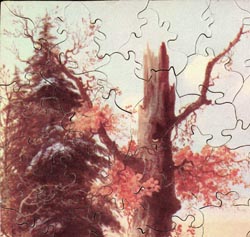
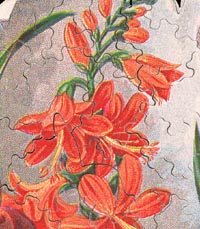
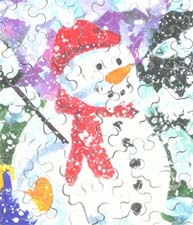
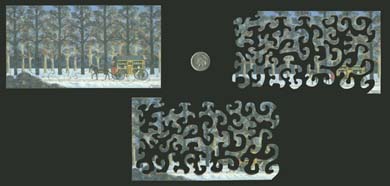
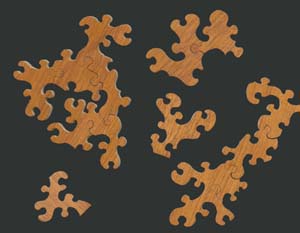
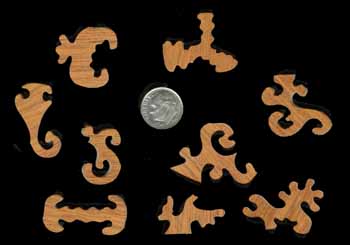
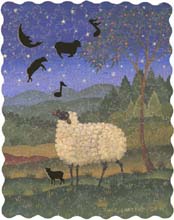

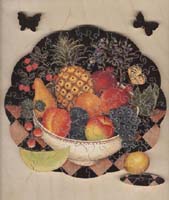
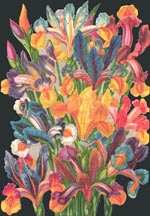
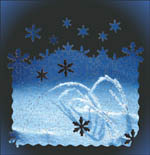


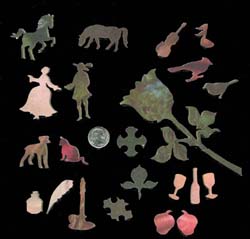

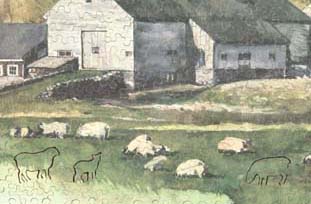
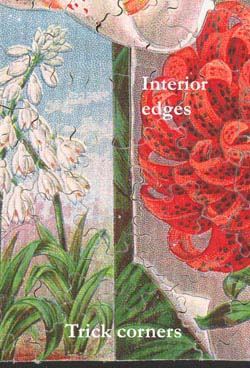
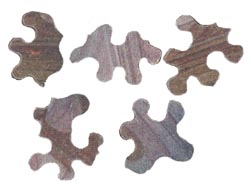 Click here to see!
Click here to see!